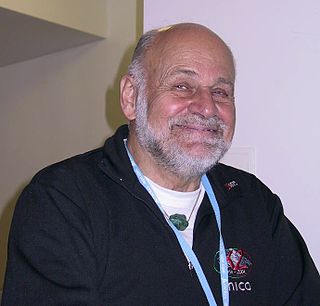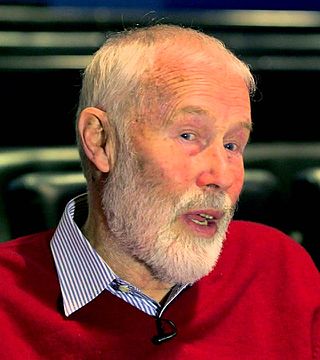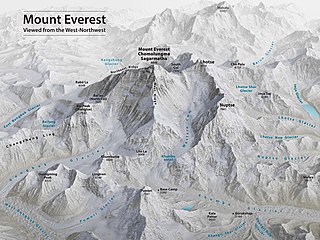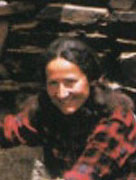Related Research Articles
The Seven Summits are the highest mountains on each of the seven traditional continents. Reaching the peak of these summits is considered a significant achievement amongst many mountaineers, alongside many other such goals and challenges in the mountaineering community. On 30 April 1985, Richard Bass became the first climber to reach the summit of all seven.

George Herbert Leigh-Mallory was an English mountaineer who participated in the first three British Mount Everest expeditions from the early to mid-1920s.

Kurt Diemberger is an Austrian mountaineer and author of several books. He is the only living person who has made the first ascents on two mountains over 8,000 metres: of Broad Peak in 1957 and of Dhaulagiri in 1960. In 2013, he won the Piolet d'Or Lifetime Achievement Award.

Sir Christian John Storey Bonington, CVO, CBE, DL is a British mountaineer.
Peter Boardman was an English mountaineer and author. He is best known for a series of bold and lightweight expeditions to the Himalayas, often in partnership with Joe Tasker, and for his contribution to mountain literature. Boardman and Tasker died on the North East Ridge of Mount Everest in 1982. The Boardman Tasker Prize for Mountain Literature was established in their memory.
The Boardman Tasker Prize for Mountain Literature is an annual prize of £3,000 awarded by the Boardman Tasker Charitable Trust to an author or authors for "an original work which has made an outstanding contribution to mountain literature". The prize was established in 1983 in memory of British climbers Peter Boardman and Joe Tasker, both of whom wrote books about their mountaineering expeditions, after their deaths on the northeast ridge of Mount Everest in 1982. It can be awarded for a piece of fiction or non-fiction, poetry or drama, although the work must have been written in English. The prize is announced at the annual Kendal Mountain Festival.

Andrew Comyn "Sandy" Irvine was an British mountaineer who took part in the 1924 British Everest Expedition, the third British expedition to the world's highest mountain, Mount Everest.

David Finlay Breashears was an American mountaineer, filmmaker, author and motivational speaker. In 1985, he reached the summit of Mount Everest a second time, becoming the first American to reach the summit of Mount Everest more than once. He is perhaps best known as the director and cinematographer of Everest (1998)—which became the highest-grossing IMAX documentary—and for his assistance in the rescue efforts during the 1996 Everest disaster, which occurred during the film's production.

The Kangshung Face or East Face is the eastern-facing side of Mount Everest, one of the Tibetan sides of the mountain. It is 3,350 metres (11,000 ft) from its base on the Kangshung Glacier to the summit. It is a broad face, topped on the right by the upper Northeast Ridge, and on the left by the Southeast Ridge and the South Col. Most of the upper part of the face is composed of hanging glaciers, while the lower part consists of steep rock buttresses with couloirs between them. The steep southern third of the Kangshung Face also comprises the Northeastern Face of Lhotse; this section may be considered a separate face altogether following the division of the South "Neverest" Buttress up to the South Col. It is considered a dangerous route of ascent, compared to the standard North Col and South Col routes, and it is the most remote face of the mountain, with a longer approach.

Mount Everest is the world's highest mountain, with a peak at 8,849 metres (29,031.7 ft) above sea level. It is situated in the Himalayan range of Solukhumbu district, Nepal.

Hannelore Schmatz was a German climber and the fourth woman to summit Mount Everest. She collapsed and died as she was returning from summiting Everest via the southern route; Schmatz was the first woman and first German citizen to die on the upper slopes of Everest.

The 1924 British Mount Everest expedition was—after the 1922 British Mount Everest expedition—the 2nd expedition with the goal of achieving the first ascent of Mount Everest. After two summit attempts in which Edward Norton set a world altitude record of 8,572.8 metres (28,126 ft), the mountaineers George Mallory and Andrew "Sandy" Irvine disappeared on the third attempt. Their disappearance has given rise to the long-standing speculation of whether or not the pair might – under a narrow set of assumptions – have reached the summit. Mallory's body was found in 1999 at 8,156 metres (26,760 ft), but the resulting clues did not provide any conclusive evidence as to whether the summit was reached.

The 1922 British Mount Everest expedition was the first mountaineering expedition with the express aim of making the first ascent of Mount Everest. This was also the first expedition that attempted to climb Everest using bottled oxygen. The expedition attempted to climb Everest from the northern side out of Tibet. At the time, Everest could not be attempted from the south out of Nepal as the country was closed to Western foreigners.

The Norton Couloir or Great Couloir is a steep gully high on the north face of Mount Everest in Tibet which lies east of the pyramidal peak and extends to within 150 m below the summit.
Peter Gillman is a British writer and journalist specialising in mountaineering topics. His book, Direttissima; the Eiger Assault (1967), also published under the title Direttissima, co-authored with Dougal Haston, told the story of the ascent of the Eiger North Face in which John Harlin II lost his life.

Guy Henry Bullock was a British diplomat who is best known for his participation in the 1921 British Mount Everest reconnaissance expedition. As expedition mountaineers, he and George Mallory found a northern access route to Everest by climbing the 6,849-metre (22,470 ft) Lhakpa La col above the East Rongbuk Glacier and by going on to reach the North Col at 7,020 metres (23,030 ft). They did not, however, reach the summit of Mount Everest.

The 1921 British Mount Everest reconnaissance expedition set off to explore how it might be possible to get to the vicinity of Mount Everest, to reconnoitre possible routes for ascending the mountain, and – if possible – make the first ascent of the highest mountain in the world. At that time Nepal was closed to foreigners, so any approach had to be from the north, through Tibet. A feasible route was discovered from the east up the Kharta Glacier and then crossing the Lhakpa La pass north east of Everest. It was then necessary to descend to the East Rongbuk Glacier before climbing again to Everest's North Col. However, although the North Col was reached, it was not possible to climb further before the expedition had to withdraw.
Pertemba, also called Pertemba Sherpa, is a professional Nepalese mountaineer, trek leader and businessman. He reached the summit of Mount Everest by the Southwest Face on the first expedition to successfully take that route, in 1975.

Ang Tharkay was a Nepalese mountain climber and explorer who acted as sherpa and later sirdar for many Himalayan expeditions. He was "beyond question the outstanding sherpa of his era" and he introduced Tenzing Norgay to the world of mountaineering.
1960 Chinese Mount Everest expedition was the first to successfully ascend Mount Everest via the North Ridge. Wang Fuzhou, Gonpo, and Qu Yinhua reached the summit at 4:20 a.m. on 25 May.
References
- ↑ Gillman, Peter (1 November 2023). "Audrey Salkeld obituary". The Guardian. Retrieved 6 May 2024.
- ↑ Nossiter, Adam (24 November 2023). "Audrey Salkeld, Pioneering Historian of Everest, Dies at 87" . New York Times . Retrieved 28 November 2023.
- ↑ Douglas, Ed (4 November 2023). "Remembering Audrey Salkeld".
- 1 2 Holzel, Tom; Salkeld, Audrey, eds. (1986). The Mystery of Mallory and Irvine. Jonathan Cape. ISBN 9780224023627.
- 1 2 3 Breashears, David; Salkeld, Audrey, eds. (1999). Last Climb: The Legendary Everest Expeditions of George Mallory. National Geographic. ISBN 9780792275381.
- 1 2 Salkeld, Audrey (1996). A Portrait Of Leni Riefenstahl. Jonathan Cape Ltd. ISBN 9780224024808 . Retrieved 6 May 2024.
- ↑ "Remembering Audrey Salkeld". Boardman Tasker Awards. 23 October 2023. Retrieved 6 May 2024.
- 1 2 Bonington, Chris; Salkeld, Audrey, eds. (1994). Great Climbs: A Celebration of World Mountaineering. Mitchell Beazley. ISBN 9781857325737.
- ↑ "Audrey Salkeld". MNTNFilm. Retrieved 6 May 2024.
- ↑ "Obituaries: Audrey Salkeld". Alpine Club. 2023. Retrieved 6 May 2024.
- ↑ Smith, Rosie; Salkeld, Audrey, eds. (1990). One Step in the Clouds: An omnibus of Mountaineering Novels and Short Stories. Hodder & Stoughton. ISBN 9780906371923.
- ↑ Salkeld, Audrey (1991). People in High Places: Approaches to Tibet. Jonathan Cape. ISBN 9780224028837 . Retrieved 6 May 2024.
- ↑ Salkeld, Audrey; Bermudez, Jose Luis (1993). On the Edge of Europe: Mountaineering in the Caucasus. Hodder & Stoughton. ISBN 9780340585474.
- ↑ Salkeld, Audrey, ed. (1998). World Mountaineering: The World's Great Mountains by the World's Great Mountaineers. Mitchell Beazley. ISBN 9781857328196.
- ↑ Salkeld, Audrey (2002). Kilimanjaro: To the Roof of Africa. National Geographic. ISBN 9780792264668 . Retrieved 6 May 2024.